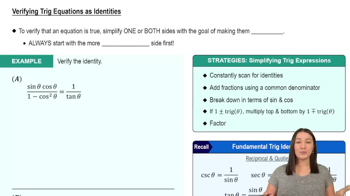Table of contents
- 0. Functions7h 52m
- Introduction to Functions16m
- Piecewise Functions10m
- Properties of Functions9m
- Common Functions1h 8m
- Transformations5m
- Combining Functions27m
- Exponent rules32m
- Exponential Functions28m
- Logarithmic Functions24m
- Properties of Logarithms34m
- Exponential & Logarithmic Equations35m
- Introduction to Trigonometric Functions38m
- Graphs of Trigonometric Functions44m
- Trigonometric Identities47m
- Inverse Trigonometric Functions48m
- 1. Limits and Continuity2h 2m
- 2. Intro to Derivatives1h 33m
- 3. Techniques of Differentiation3h 18m
- 4. Applications of Derivatives2h 38m
- 5. Graphical Applications of Derivatives6h 2m
- 6. Derivatives of Inverse, Exponential, & Logarithmic Functions2h 37m
- 7. Antiderivatives & Indefinite Integrals1h 26m
- 8. Definite Integrals3h 25m
0. Functions
Properties of Logarithms
Problem 77d
Textbook Question
Determine whether the following statements are true and give an explanation or counterexample.
 Verified step by step guidance
Verified step by step guidance1
Step 1: Understand the statement. The statement given is 2 = 10^{\log_{10}2}.
Step 2: Recall the property of logarithms. One important property is that if a = b^{\log_b(a)}, then the statement is true.
Step 3: Apply the property to the given statement. Here, a = 2 and b = 10, so we have 2 = 10^{\log_{10}(2)}.
Step 4: Verify the property. Since the base of the logarithm (10) and the base of the exponent (10) are the same, the property holds true.
Step 5: Conclude that the statement is true based on the logarithmic property.
Recommended similar problem, with video answer:
 Verified Solution
Verified SolutionThis video solution was recommended by our tutors as helpful for the problem above
Video duration:
1mPlay a video:
Was this helpful?
Key Concepts
Here are the essential concepts you must grasp in order to answer the question correctly.
Logarithmic Identity
The logarithmic identity states that for any positive number 'a' and 'b', the equation a = b^log_b(a) holds true. This means that raising the base 'b' to the logarithm of 'a' with base 'b' will yield 'a'. This identity is fundamental in understanding how logarithms relate to exponentiation and is crucial for evaluating expressions involving logarithms.
Recommended video:

Verifying Trig Equations as Identities
Properties of Logarithms
Logarithms have several key properties that simplify calculations, such as the product, quotient, and power rules. For instance, log_b(xy) = log_b(x) + log_b(y) and log_b(x/y) = log_b(x) - log_b(y). Understanding these properties allows for the manipulation of logarithmic expressions, which is essential for verifying the truth of statements involving logarithms.
Recommended video:

Change of Base Property
Base of a Logarithm
The base of a logarithm is the number that is raised to a power to obtain a given number. In the expression log_b(a), 'b' is the base. Different bases can yield different results, and it is important to recognize that the base must be positive and not equal to one. This concept is critical when evaluating logarithmic expressions and understanding their implications in equations.
Recommended video:

Change of Base Property






